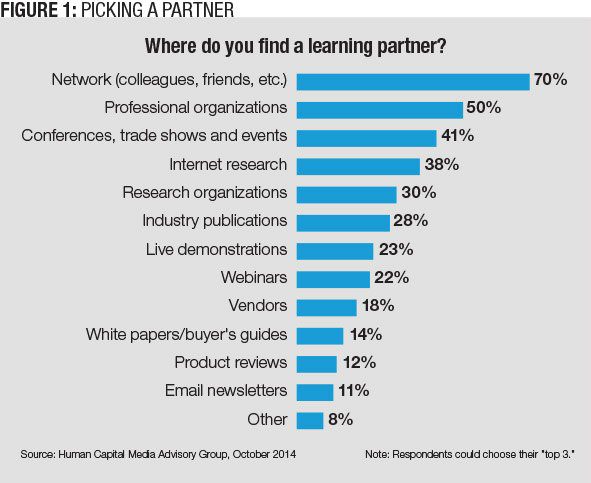Learning and development organizations are complicated,spanning technology, content development, delivery and measurement. With expanding responsibilities, and often constrained by budget and expertise, many enterprises leverage external partners for help. How chief learning officers leverage partners is almost as complex as learning itself, but understanding the priorities and pitfalls in business partner dynamics can help CLOs build more effective relationships.
Every other month, IDC surveys Chief Learning Officer magazine’s Business Intelligence Board to gauge the issues, opportunities and attitudes that are important to senior training executives. In October 2014, nearly 400 board members gave their opinions on various types of business partners, how they choose vendors and where they are satisfied and dissatisfied with vendor partners.
Choosing a Learning Vendor
CLOs report leveraging a wide range of sources from white papers to analysts, trade shows, professional organizations and their networks to identify appropriate vendors. Seventy percent use peers and colleagues, 50 percent use professional organizations and about 40 percent use conferences and trade shows (Figure 1).

There are many secondary sources to identify appropriate training partners including buyer’s guides, industry publications or even market research. Those secondary sources are then validated or discarded based on recommendations from trusted sources. They also provide CLOs with context for various solutions to support the selection process. One CLO said he specifically looks for partners that “are available for questions and who share workplace learning information.”
For CLOs, these findings reinforce the primary reasonto cultivate a strong personal and professional network: having a trusted source of information and advice. It also implies the value of cultivating and maintaining a smaller, closer set of connections to facilitate another vetting layer when considering a new learning partner.
CLOs also leverage a wide range of criteria to assess a particular vendor or product for a specific relationship after the initial vetting process. While the most important factor in selecting a vendor is the quality of the product or service, three other characteristics are in that top tier: value, results produced and ease of working with the vendor (Figure 2).
Similar to last year’s results, three characteristics in the second tier also lead to benefit for CLOs: customization, problem solving and innovation. Third tier characteristics support capabilities that lend credibility to the product or services, but are tangential to the primary objective: recommendations, related services or support, and the partner’s brand reputation.
When asked to describe the challenges CLOs encounter with vendors, the issues often revolve around flexibility and the vendor’s ability to listen and respond to specific enterprise issues. One CLO said she looks for a partner who “works to understand your business challenges, [is] flexible and makes recommendations.” Another agreed that “flexibility and the ability to collaborate effectively” were most important.
The third tier characteristics reflect characteristics that can help sell internal stakeholders on a selection. For instance, recommendations can help demonstrate a vendor’s credibility, and support services demonstrate a vendor’s confidence the solution will work in the real world.
Several CLOs mentioned customization explicitly when describing their priorities for selecting a training partner: “Willingness to listen to our needs and requirements and customize to meet them,” said a CLO of a mid-sized firm. One senior learning leader underscores the benefit of both flexibility and customization. She values a vendor “who takes the time to learn about our organization, our services, our people and then customize to our unique organization.”
This makes sense. Even the best relationship is doomed if the product or service is inferior or fails to provide organizational benefit. Partners and products ability to stretch beyond their current, standard offerings is essential to a CLOs long-term satisfaction.

What Makes a Great Business Partner?
The implication of this finding is straightforward but can be profound: While it is easy to find a product and search for the right circumstance to deploy it, that approach is backward. The first step to identify a high-quality product is to understand precisely the problem to be solved and the users’ expectations. Expecting a solution to work outside of that defined set of problems and contexts is a recipe for dissatisfaction.
CLO comments on what makes a great business partner reflect this need for alignment between vendor and problem. One CLO described the characteristic that makes a great partner as “being flexible, understanding my industry and my constraints, and above all — being available for communication! Return my phone calls or emails within a reasonable time frame.”
Understanding the constraints of the specific industry was a recurring theme. One CLO said: “As I work within the mining industry, this requires vendors to accept and understand our operational priorities and the need for flexibility in delivery and in some cases customization of content. A vendor that can tick these boxes with the addition of consistent performance would be a great business partner in my eyes.”
That need for alignment points to one of the most frequently cited characteristics in a valued partner: A vendor who asks the right questions and listens to the answers — “They listen, understand, and work with you … Within a 15-minute call, I can tell if a vendor will be good to work with or not. If they’ve heard what I’ve said, can articulate what I need, and be upfront, honest and clear with me.” Another CLO said, “An account manager who listens and can understand our business needs and recommend and validate a solution to meet our needs” is a great partner. But it goes beyond listening: “A vendor who listens is important. A vendor who adds to the conversation in a productive and proactive manner is essential.”
CLOs understand the risks of getting highly visible solutions wrong. Many vendors understand it too, and generally, CLOs are satisfied with their learning and development business partners. Four out of 5 enterprises leverage external partners/providers for some aspect of their learning and development function such as learning technology, content development, delivery or learning measurement. More than 85 percent of CLOs report they are satisfied with those providers.
In some specific areas of learning and development, CLOs report even greater satisfaction. In learning technologies, content development, learning delivery, learning analytics, executive education/coaching and learning strategy/organization consulting, CLOs report being satisfied more than 90 percent of the time with their learning partners. In the case of learning delivery, 93 percent of CLOs report being satisfied with their business partner. For content development, 88 percent of CLOs report being satisfied or very satisfied. CLOs are also satisfied with executive education/coaching services and learning consultants or providers (Figure 3).
Vendors: Square Peg, Round Hole
While those numbers are strong, there is room for improvement. While 73 percent of CLOs areeither satisfied or very satisfied with their learning technology provider, only 23 percent are very satisfied. Worse, only 22 percent of CLOs are very satisfied with learning analytics and only another 40 percent are satisfied.
Learning partners aren’t perfect. Specifically, they can improve how they work with companies todevelop the most appropriate solutions. One CLO lamented partners who “do not always tell the truth or are not transparent; they sometimes misrepresent functionality or capability of a product or system; they are not always flexible.” Another suggested vendors “try to provide an off-the-shelf solution, which often is not a result of truly listening to our needs and desired outcomes.”

CLOs said vendors fixate on “selling a square peg solution for a round hole need.” In some cases,interaction between vendors is frustrating: “There are very few vendors that create e-learning for mobile learning delivered through an LMS. They say they know mobile, but they don’t … it’s [because] LMS and eLearning vendors are not working cohesively, so true mobile capabilities are not yet out there.”
But CLOs are optimistic vendors and consultants have more to offer, and that they can take advantage of that knowledge and capability if they could access it: “The best vendors remain deeply knowledgeable of trends and technologies that can produce business value. They know what works and can provide introductions and/or benchmarking opportunities for solutions that meet our needs.”
For most CLOs, working with learning partners — either for content, technology or services — is a necessity. To be really satisfied, however, they may need to act to thoroughly vet the partner and reduce potential disappointment. To maximize the value of these relationships, consider the following:
- Before selecting a product or a service provider, assure organizational requirements are clear for all stakeholders.
- Cultivate a wide range of sources, and maintain a smaller set of connections to help formally and thoroughly vet learning partners before signinga contract.
- Even when satisfied with current providers, expect more. There is often more insight, more innovation and more opportunity for value than is visible in the first — or 10th — draft of the solution.















